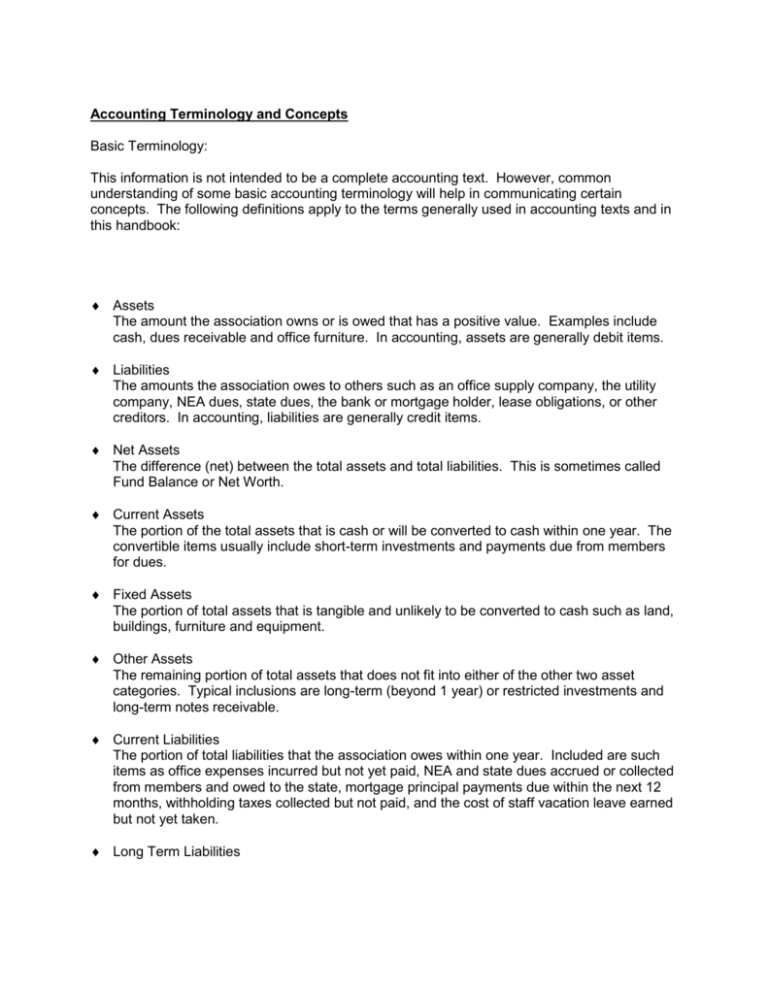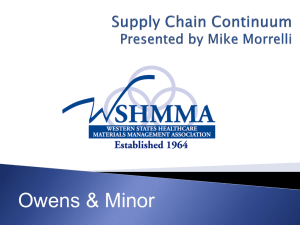Accounting Terminology and Concepts Basic Terminology: This
advertisement

Accounting Terminology and Concepts Basic Terminology: This information is not intended to be a complete accounting text. However, common understanding of some basic accounting terminology will help in communicating certain concepts. The following definitions apply to the terms generally used in accounting texts and in this handbook: Assets The amount the association owns or is owed that has a positive value. Examples include cash, dues receivable and office furniture. In accounting, assets are generally debit items. Liabilities The amounts the association owes to others such as an office supply company, the utility company, NEA dues, state dues, the bank or mortgage holder, lease obligations, or other creditors. In accounting, liabilities are generally credit items. Net Assets The difference (net) between the total assets and total liabilities. This is sometimes called Fund Balance or Net Worth. Current Assets The portion of the total assets that is cash or will be converted to cash within one year. The convertible items usually include short-term investments and payments due from members for dues. Fixed Assets The portion of total assets that is tangible and unlikely to be converted to cash such as land, buildings, furniture and equipment. Other Assets The remaining portion of total assets that does not fit into either of the other two asset categories. Typical inclusions are long-term (beyond 1 year) or restricted investments and long-term notes receivable. Current Liabilities The portion of total liabilities that the association owes within one year. Included are such items as office expenses incurred but not yet paid, NEA and state dues accrued or collected from members and owed to the state, mortgage principal payments due within the next 12 months, withholding taxes collected but not paid, and the cost of staff vacation leave earned but not yet taken. Long Term Liabilities The portion of total liabilities that the association owes beyond one year. The major inclusions are the mortgage balance, severance pay earned by long time employees, longterm notes and capital lease commitments. Statement of Financial Position (often called the Balance Sheet) The report includes assets, liabilities and net assets. The “balance” is arrived at as follows: Total Assets – Liabilities = Net Assets Or Total Assets = Liabilities + Net Assets (1) (1) Assets What is owned = (2) + (3) Balance Sheet____________________________ (2) Liabilities What is owed (3) Net Assets Difference between assets and liabilities Left hand side (Debit items) Right hand side (Credit items) Receipts Includes all cash received, whether it is “revenue” for the Association or not. Non-revenue items can include NEA and state dues, security and damage deposits for rental space and expense reimbursement from outside sources. Revenue Receipt of cash (or a promise to pay) in exchange for an item or a service delivered to someone within a fiscal year. Typical items included are local association dues, NEA and state projects, and related funds and interest earned on investments. Please note that NEA and state dues are “pass through” amounts that are recorded as Revenue at the organizational level where the dues are owed, not at the local. Disbursements Includes all cash paid out, whether it is an expense for the association or not. Non-expense items may include transmittal of NEA and state dues, purchase of fixed assets (land, buildings, furniture and equipment), and advances to staff or leaders. Expenses Disbursements of cash (or a promise to pay) for an item or a service received, used or consumed within the fiscal year. Typical items included are salaries, benefits, paper and other office supplies, mileage reimbursement, meals, lodging, office rent, etc. Current Ratio This is a measure of financial liquidity and ability to pay obligations as they become due. The ratio is the current assets divided by the current liabilities. This represents the number of dollars of current assets that are available to pay current liabilities. A ratio of 1.0 to 1.5 is minimal. It should never be less than 1. A ratio of at least 1.5 (of current assets) to 1.0 (of current liabilities) is an indicator of a desirable financial position. Internal Control The procedures, practices and systems that provide assurance of the completeness and accuracy of the accounting data used in decision-making. According to the American Institute of Certified Public Accountants Statement on Auditing Standards, it is “…the plan of an organization and all of the coordinate methods and measures adopted within a business to safeguard its assets, promote operational efficiency, and encourage adherence to prescribed managerial policies.” Depreciation An accounting technique for allocating the cost (expense) of a fixed asset over its estimated useful life. Auditors typically use the “straight line” method for determining the amount to allocate. The annual amount is determined by dividing the cost (total cost including taxes, freight etc.) of the item by the number of years it is expected to last and then transferring that amount to a depreciation expense account each year. (E.g. A computer that costs $3,000 and has a useful life of 3 years would be depreciated at a rate of $1,000 per year.) This recognizes a depreciation expense of $1000 each of the 3 years and reduces the value of the asset (accumulated depreciation) by the same amount each of the 3 years. Accrual The process of recognizing income in the fiscal year in which it is “earned”, regardless of when the cash is received or of recognizing expense when it is “incurred”, regardless of when the bill is paid. An example would be the recording of the annual dues obligation as income when a membership form (or group of forms) is processed rather than just recognizing the amount of cash received. On the expense side, it means recording the expenses that have been incurred at the end of each month even if the payments have not yet been made. An example would be recording insurance expense incurred but not yet paid. Chart of Accounts The list of all accounts used in the accounting system, including account codes (e.g. Account 101 – Bank of America Checking Account, Account 210 – Accounts Payable, Account 301 – Dues Income, Account 410 – Travel Expense). Double Entry Bookkeeping Every transaction must have both a debit and credit totaling an equal value: for example, a debit to cash would be offset by a credit to an income account, a liability account or another asset account. A checkbook is a single entry bookkeeping system. Cash, Bank Balance & Checkbook Balance - Cash Use of this term includes coins, currency and checks (e.g. petty cash fund, checking account). - Bank Balance The amount remaining at a given date in a checking or savings account shown on the monthly bank statement. This is to be reconciled with the cash/checking account balance shown on the association’s books. The bank balance may differ from the checkbook balance due to timing differences. (Refer to Section IV – Accounting Systems – for Bank Reconciliations) - Checkbook Balance The checkbook balance is equal to funds deposited less checks issued and bank charges. Cash Accounting Cash accounting is a system whereby income and expense are recognized in the fiscal period only when cash is actually received or expended. Accrual Accounting As distinguished from cash accounting, accrual accounting is a system whereby income and expense are recognized in the fiscal period in which they belong (earned or incurred); regardless of the time cash is received or expended. Accrual accounting requires additional accounts not found in a cash system. These additional accounts include: Accounts Receivable: (a) Recognizes income (a credit) before cash is received. The debit, as the offsetting (double) entry, goes to the receivable account. (b) When cash is received, cash is debited and the receivable is credited. CASH (b) $500 ACCOUNTS RECEIVABLE (a) $500 (b) $500 INCOME (a) $500 Accounts Payable: (a) Recognizes expenses (a debit) before cash is disbursed. The credit, as the offsetting (double) entry, goes to the payable account. (b) When cash is disbursed, cash is credited and the payable is debited. CASH (b) $200 ACCOUNTS PAYABLE (a) $200 (b) $200 EXPENSE (a) $200 Prepaid Expense: Recognizes that a disbursement of cash is for expense in a future period (future benefit). (a) A prepaid expense (asset) is debited and cash is credited when the disbursement is made. (b) In a future period when the expense is recognized, the prepaid expense account is credited and the expense account is debited. CASH (a) $300 PREPAID EXPENSE (a) $300 (b) $300 EXPENSE (b) $300 Deferred Income: Recognizes that receipt of cash is for income in a future period. (a) A deferred income account (liability) is credited and cash is debited when cash is received. (b) In a future period when the income is recognized, the deferred income account is debited and the income account is credited. CASH (a) $400 DEFERRED INCOME (a) $400 (b) $400 INCOME (b) $400 The key to interpreting a statement based on accrual accounting is to recognize that reported income may not yet be reflected in cash received and reported expense may not yet be reflected in cash expended. Receivables and payables should be examined as well to get a complete picture of the financial health of the association. The value of accrual accounting is that it gives you a more complete picture of your financial status than does the cash method. Accrual accounting, however, does assume there will be total collection of all receivables, which is seldom true.





